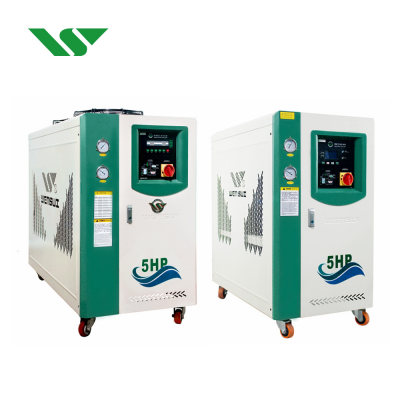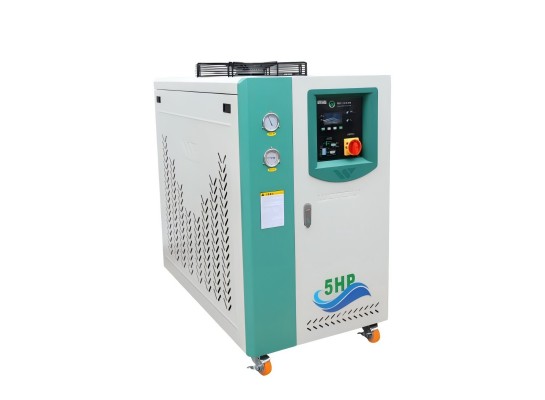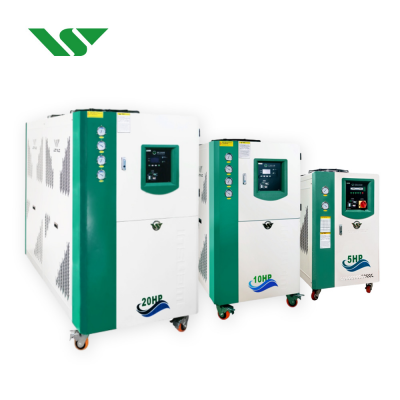What is an Air-Cooled Water Chiller?
2024-08-19 Page view:
An air-cooled water chiller is a type of chiller that cools water from room temperature to a specific lower temperature using a compressor. This cooled water can then be used to cool down molds or machines. Air-cooled chillers work independently with a built-in fan as the heat dissipation device. These chillers consist of three main interconnected systems: the refrigerant circulation system, the water circulation system, and the electrical automatic control system.

Refrigerant Circulation System:
In this system, the liquid refrigerant in the evaporator absorbs heat from the water, causing it to evaporate. This process creates a temperature difference between the refrigerant and the water. The refrigerant, now in a gaseous state, is then compressed by the compressor, which increases its pressure and temperature. The gaseous refrigerant releases heat in the condenser, turning it back into a liquid. This liquid then passes through an expansion valve, which reduces its temperature and pressure before entering the evaporator to continue the cycle.
Water Circulation System:
The water pump in this system circulates water from the tank to the equipment that needs cooling. The chilled water absorbs heat from the equipment, causing its temperature to rise, and then returns to the chilled water tank for further cooling.
Electrical Automatic Control System:
This system includes the power supply and automatic control components. The power supply provides electricity to the compressor, fan, and water pump. The automatic control part involves a thermostat, pressure protection, delay relay, and overload protection, all of which work together to manage automatic operations such as starting and stopping based on water temperature.

Key Components of the Chiller Refrigeration System:
Condenser: The condenser is crucial in the refrigeration process, where it dissipates heat and condenses the refrigerant. After the refrigerant is compressed, it enters the condenser as high-pressure steam and releases the heat absorbed during the cooling process, condensing back into a liquid.
Liquid Reservoir:Located after the condenser, the liquid reservoir stores the condensed refrigerant. It helps manage fluctuations in refrigerant demand and ensures efficient operation, particularly when the heat load on the evaporator varies.
Dry Filter:The dry filter removes moisture and contaminants from the refrigerant. Moisture can cause ice blockages in the system, leading to operational issues. The dry filter ensures the refrigerant cycle remains clean and efficient.
Evaporator:The evaporator is a heat exchanger where the refrigerant absorbs heat from the medium being cooled, causing it to evaporate. This process cools the medium, allowing the chiller to maintain the desired temperature.
Thermal Expansion Valve: This valve controls the flow of refrigerant into the evaporator, reducing its pressure and temperature. It ensures the refrigerant enters the evaporator at the right state to absorb heat effectively.

Applications and Benefits of Air-Cooled Chillers:
Air-cooled chillers are versatile and can be used in various applications. They are often preferred in smaller systems, while larger systems may use water-cooled chillers. Although air-cooled chillers have a slightly higher initial investment cost, they offer lower annual operating costs and easier maintenance.
Cooling in Plastic Processing: Air-cooled chillers are used to cool the molding molds in plastic processing machinery. This improves the surface finish of plastic products, reduces internal stress, prevents shrinkage and deformation, and accelerates the molding process.
Machine Tool Cooling: Air-cooled chillers are also used in CNC machines, grinders, and other precision machine tools to control oil temperature and reduce thermal deformation, which improves machining accuracy.
Product Features:
Advanced Control Panel: The chiller features a touch-type waterproof and dustproof control panel, allowing temperature adjustment from 5°C to 30°C.
Energy-Efficient Compressor: It uses a new, original imported compressor from the Daikin or Panasonic series, enhancing energy efficiency.
Effective Condenser and Evaporator Design: The condenser has a vertical shell-and-tube design, and the evaporator uses internally threaded copper tubes, improving heat transfer and making cleaning easier.
High-Quality Water Pump: The water pump, sourced from Italy or Taiwan, provides high flow rates and is both safe and quiet to operate. 4.5 Durable Body Shell: The chiller's body is painted with electrostatic powder paint, ensuring a beautiful and durable finish.
Durable Body Shell: The chiller's body is painted with electrostatic powder paint, ensuring a beautiful and durable finish.
Stainless Steel Water Tank: Equipped with a float automatic water replenishment device, the stainless steel water tank is easy to clean and helps improve work efficiency by measuring and controlling water levels.
In summary, air-cooled chillers are an economical and low-maintenance option for cooling applications in various industries. They offer several advantages, including lower operating costs and efficient cooling, making them a popular choice for modern industrial applications.
-
2024-09



